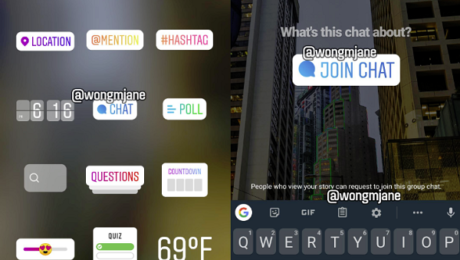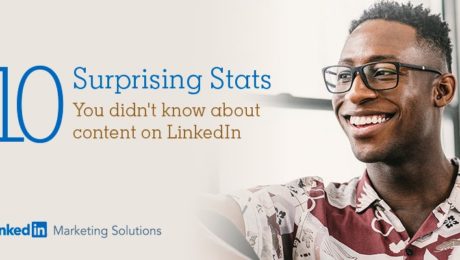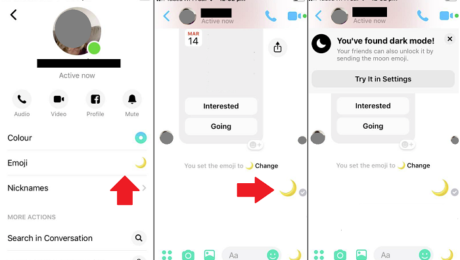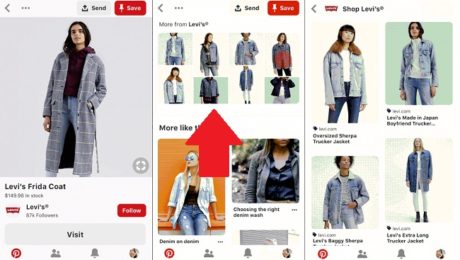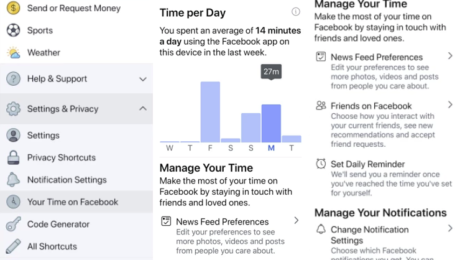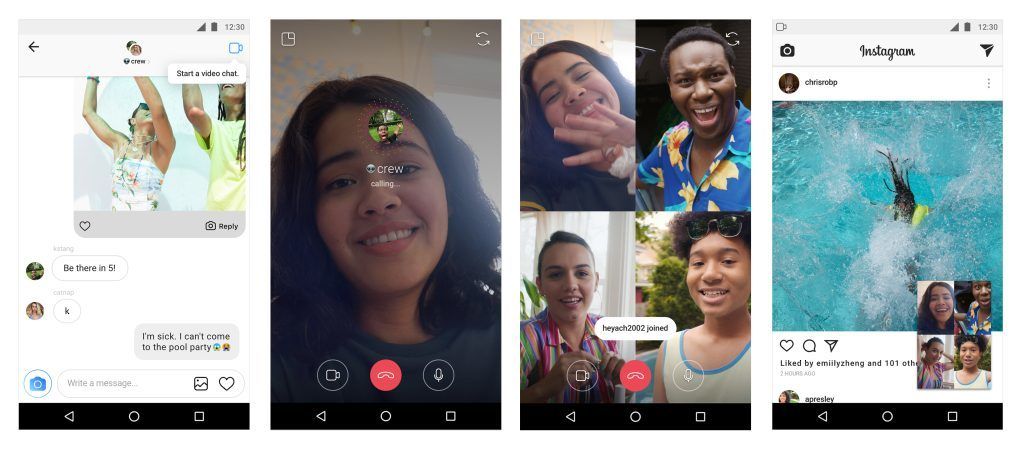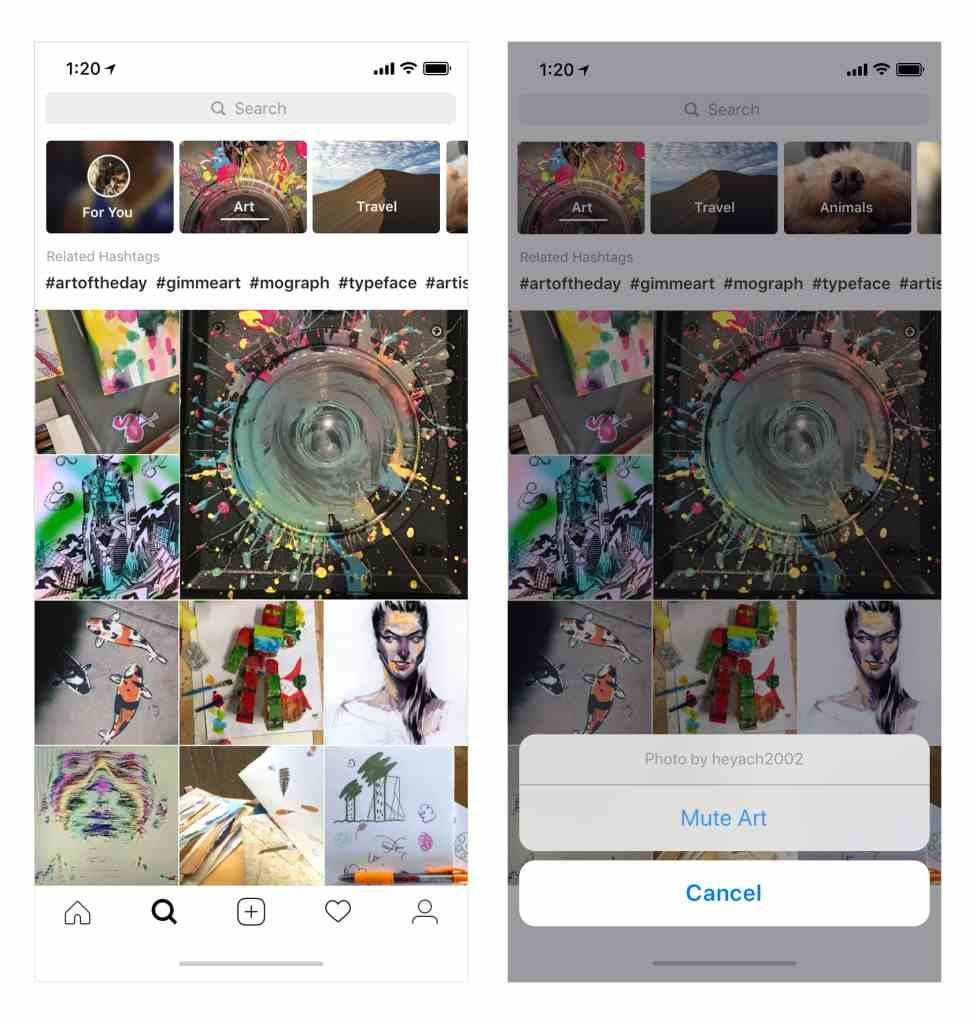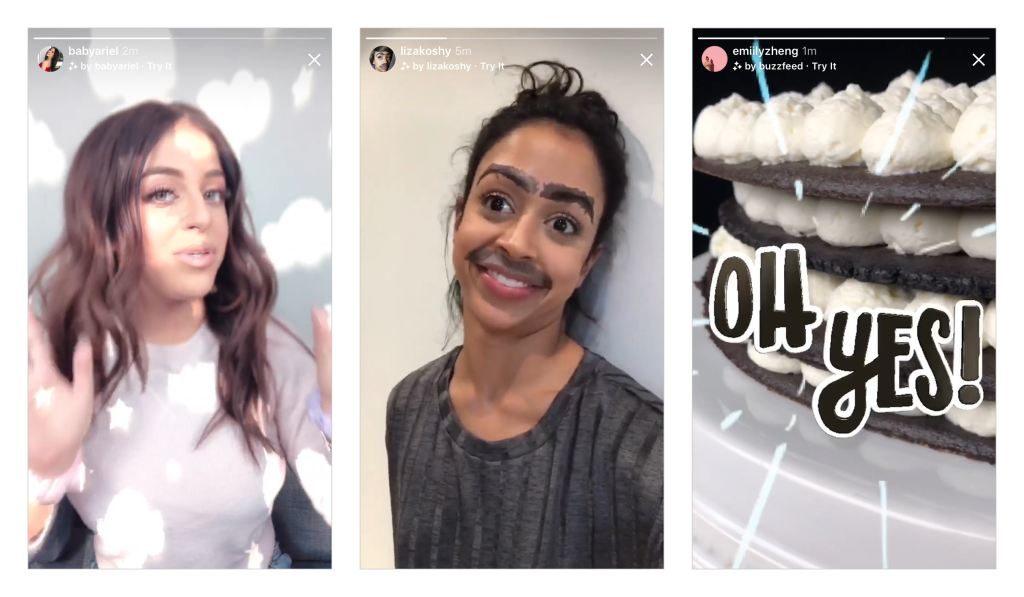It seems that it’s not only Facebook’s main app that’s putting more focus on private groups – over on Instagram, reverse engineering expert Jane Manchun Wong has uncovered a new ‘Join Chat’ sticker option which would enable Stories viewers to join a private chat group, direct from a Story.
As you can see here, the ‘Join Chat’ sticker prompts the user to add a note on what the chat is about, with the lower note saying: ‘People who view your story can request to join this group chat’.
Along with Facebook more broadly, Instagram has been putting increased emphasis on messaging, with more than half of the app’s users now also using Instagram Direct. Instagram Direct has also proven to be a strong driver of engagement and connection on the platform, with around 85% of the messages shared on Instagram distributed among the same three friends, as opposed to broader groups. 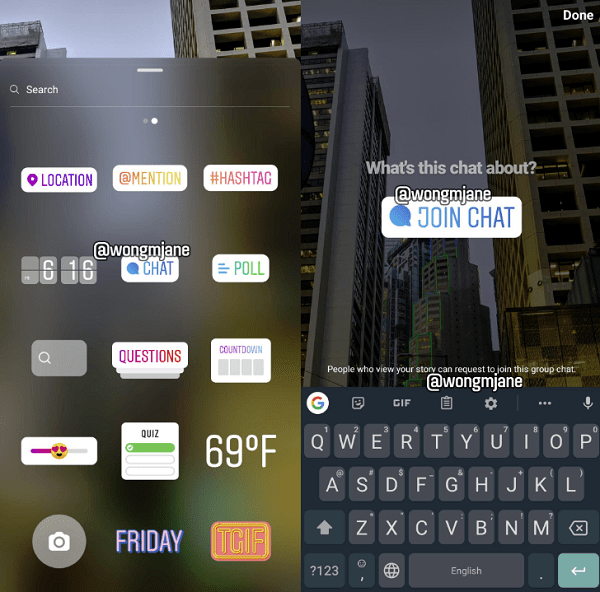
This new option looks to put more emphasis on this, prompting private group discussion and sharing, which aligns with the above-noted trends, while also sparking interest in yet another aspect of the Instagram experience.
For brands, if this is indeed launched, it could provide another way to build stronger community connection, and bring your biggest advocates closer by sharing exclusive content and/or seeking consultation. That could be particularly helpful on Instagram, given the power of influencer marketing on the platform – if you can build stronger connection with your top followers, that could give your brand building efforts a significant boost.
There’s no word as yet from Instagram as to whether this feature will be released, but we’ll keep you updated as we hear.
Follow Andrew Hutchinson on Twitter
In its recent quarterly update, Microsoft, the parent company of LinkedIn, reported that the professional social network continues to see ‘record levels of engagement‘, with on-platform sessions growing by 24%.
LinkedIn engagement has been on the rise for some time – but where, exactly, is that growth coming from and what types of content are generating more interest on the site?
Delving deeper into this, LinkedIn has published a new infographic, which outlines a range of updated engagement stats, which may help you better plan your platform strategy.
Among the data points listed:
- Top publishers have seen an average 120% growth in Page followers YoY
- Video is the content type most likely to spark conversation
- Messages sent have increased 35% YoY

After recently launching a new Interest Targeting option for LinkedIn ads, which is based on the content people engage with on the platform, LinkedIn is now broadening its ad targeting toolset even further, with the addition of three new options to help hone in on your specific target audience.
The three new options being launched are ‘lookalike audiences’, ‘audience templates’, and the addition of Microsoft Bing search data to beef up interest targeting. Here’s how each will work.
Lookalike Audiences
Digiday reported back in January that LinkedIn was working on its own variation of Lookalike Audiences, and now, LinkedIn has officially confirmed the addition.
As per LinkedIn:
“LinkedIn’s lookalike audiences combine the traits of your ideal customer with our rich member and company data to help you market to new professional audiences similar to your existing customers, website visitors and target accounts. Since these members are already on LinkedIn, they’re in the right professional mindset to engage and respond to your brand.”
Similar to how the process works on other platforms, Lookalike Audiences will enable you to upload an email list from your CRM, for example, or a list of people who have visited your website, then LinkedIn’s system will match those details against its database to come up with a new audience of users who share similar traits.

Lookalike audiences have proven highly effective on other platforms, taking some of the effort out of identifying and focusing on the right audience. If the system is able to detect relevant, similar traits, this can be a great way of reaching new people who are likely to be interested in your offerings.
This may actually be even more potent on LinkedIn, as it will be able to detect new user segments based on job title and position information, which could help ensure you get your ads in front of the exact right decision makers, and capitalize on industry trends and shifts.
LinkedIn says that the option has proven effective in its initial trials:
“Customers in our pilot were able to improve their campaign reach by 5-10x while still reaching the kind of high-quality audiences that matter most to their organizations.”
This could become a key consideration for all LinkedIn ad campaigns.
Audience Templates
Audience Templates, meanwhile, aim to make it easier for people who are less certain about their target market, or have less training data to go on, to reach relevant users on the platform.

As you can see here, the Audience Templates option – shown on the right of the screenshot – will enable advertisers to search for a market segment that relates to their offering. You just enter in the type of people you’re trying to reach and LinkedIn will provide a match based on its system detail.
At this stage, there are around 20 predefined B2B audiences to choose from, though LinkedIn notes that is expanding.
Get ready for good news Instagram fans.
As per social media code hacker Jane Manchun Wong:
One of the most requested features, Instagram is looking to add a new way to search through posted videos, enabling you to find specific moments.
Of course, most platforms already provide this functionality – as does Instagram itself on IGTV videos – but this new tool will make it easier to locate key points within uploaded content. It may not seem like a big deal, considering Instagram videos can only be 60 seconds long, but it will be a helpful addition, that’ll likely see significant use. If it’s actually rolled out, of course.
Instagram has kept a tight leash on content controls and options – you can only view one Instagram post at a time, for example (as opposed to swiping through each post from a profile), while you can’t include any links in your captions. As the platform expands, it’s looking to add in additional functionality to cater to user demand.
There’s no word from Instagram as to when, or if, this will be released, but given it’s now in the back-end, it’s likely close to seeing a proper roll out.
After testing it out for the last few months, Facebook is now rolling out its new ‘Dark Mode’ for Messenger – but they’ve hidden the function, Easter egg style, behind an in-app emoji trick.
Here’s how you can activate the new function – and a disclaimer, this may not be available to all users as yet (I tried it on two devices, on one, it worked, on the other it didn’t).
First, ensure the Messenger app on your device is updated to the latest version.
Next, go into any chat and head into that specific conversation’s settings by tapping on the name of the person, or people, in the discussion at the top of your Messenger window.
Within the chat settings, change the chat emoji to the moon image. Now, head back into the chat and send the same moon emoji as a message.

For some users, this is enough to activate Dark Mode (you can see the prompt in the third screenshot above noting that ‘You’ve found dark mode’), but for others, you may have to actually double-tap the moon emoji within the chat. I had to tap on the moon emoji a few times – eventually, it sparked a flood of moons falling down the screen, then the dark mode prompt appeared.
Once you’ve ‘found’ dark mode, you can tap on the prompt to head to settings and activate it.

As noted, this may or may not be active for all users at this stage – some are saying it’s not active for them, and as noted, I tried it on a couple of devices with differing results.
Either way, it likely does mean that Facebook will roll out dark mode to all users soon, not just those who know this trick. Facebook first previewed Messenger dark mode as part of its broader app revamp announcement last May, while code hacker Jane Manchun Wong shared screenshots of the option in development back in October.
Ahead of a potential IPO later in the year, Pinterest is ramping up its eCommerce tools, this time through the addition of new product catalogs and personalized shopping recommendations, in order to maximize business potential.
First, in addition to the ‘More like this’ option beneath each Pin, which uncovers visually similar items, Pinterest is also adding a ‘More from [brand]’ option, which will showcase a broader range of product Pins from the same business.
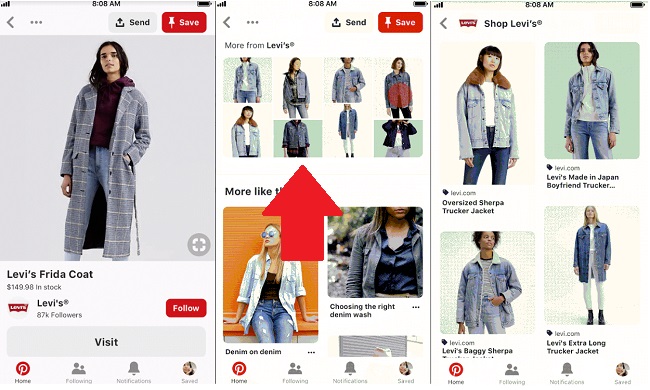
As you can see in the above example, when you scroll down from a Pin, there’ll be a new option, where available, to also tap on the ‘More from [brand]’ list, which will showcase similar items, but confined to that provider. That’ll definitely prove popular with brands – at present, the ‘More like this…’ option can take users away from their offerings, even if they might have similar product in their catalog that would fit the bill. This option will enable businesses to keep users around for longer, and help facilitate brand loyalty on the platform.
Next up, Pinterest is also adding in new personalized shopping recommendations:
“Alongside style, home, beauty and DIY boards, you’ll see in-stock ideas related to what you’ve been saving, to match your style. Just click “more ideas” then the shopping tag to start shopping ideas picked for you. Tap + to quickly add the Pin to your board, or click the Pin to go straight to checkout on the retailer’s site.”

The addition will provide more ways for Pinners to find available products similar to what they’re interested in, with direct buying options, making it easier to get more shopping ideas.
Pinterest will also now enable brands to upload their full catalog to the platform, and turn their products into dynamic Product Pins. This compliments the platform’s recent announcement of automated ‘Shop the Look’ Pins, which are able to identify products within Pins and connect them to buying options. Uploading your product catalog will ensure your products show up for more of these automated recommendations, boosting your business potential on the platform.
In addition to this, Pinterest is also making its Shopping Ads available to all businesses through its self-serve ad tool, and it’s expanding its ‘Shopping search’, in order to showcase more products to buy for related on-platform queries.
As noted, the updates expand Pinterest’s eCommerce potential, adding in more ways for users to find, and buy, relevant items, related to their search history, their interests and specific brands. That will make the platform more inviting for businesses – already, research has shown that Pinterest drives far higher purchase intent than other platforms, with some 90% of Pinnersusing the platform to plan for or make purchases.
Pinterest may have relatively fewer users (250 million) than other social platforms – but Pinterest has repeatedly stated that its, in fact, not a social network. It’s become a ‘discovery engine’, ‘a catalog of ideas’, and in that sense, Pinterest, in many ways, is in a league of its own – a sort of middle ground between Google search and Amazon product listings, but more driven by your personal preferences and interests.
It’s taken a while, but Facebook is now rolling out its promised ‘time spent’ dashboard within its main app, enabling users to track the time they’re active on Facebook each day, and set prompts to limit their use.

As you can see from the above screenshots, the new dashboard is available within the functions listing, and through it, you can see your total time spent, set daily reminders, and change your settings to make better use of your time.
The options are very similar to what Instagram launched last week, which are part of the broader ‘digital wellbeing’ push within tech circles that’s been initiated in response to a range of reports about the potential negatives of overuse of digital platforms.
Inside Starbucks’ secretive, ad-free Facebook community for fall enthusiasts
What exactly is the Leaf Rakers Society? Learn how Starbucks built a 26,000-member community of die-hard Pumpkin Spice Latte fans.
Facebook itself commissioned a report which found that passive engagement on social can lead to negative mental health impacts. That finding puts Facebook, as a business, in a tough position – on one hand, it needs to make you come back to the platform and use it as much as possible to boost its usage stats (and attract more ad dollars), but on the other, there are user welfare concerns with the same.
In this respect, Facebook’s new tracking tools seem somewhat like a red flag being waved by a matador – yes, they seek to address the core issue, but not really.
As noted by Techcrunch:
“Facebook and Instagram’s versions are particularly toothless. There are no options to force you to ease off your usage, just a quick daily limit notification to dismiss. iOS 12’s Screen Time at least delivery’s a weekly usage report by default so the feature finds you even if you don’t go looking for it. And Android’s new Digital Wellbeing dashboard is by far the most powerful, graying out app icons and requiring you to dig into your settings to unlock apps once you hit your daily limit.”
Really, the apps themselves are not responsible for how you use your time – if you choose to spend your free hours mindlessly scrolling through Facebook, that’s up to you. The providers can give you access to tools to highlight the potential problems with this, but they can’t necessarily enforce any ‘rules’ around use. It is possible that they could do more, as TechCrunch notes, and Facebook could also provide more insight into how, specifically, you’re spending your time in its apps, which may help to guide your usage. But the tracking dashboards are, looking at the other side of the argument, at least a first step.
So long as people go looking for them. Will you check out your Facebook usage stats?
I’m willing to bet the majority of users of both apps won’t bother – because who wants to know how much time you’ve wasted? Who wants to be shown the hours they could have spent doing something more productive? Hence, the red flag analogy – yes, Facebook is providing tools to help, but really, they’re somewhat meaningless in the broader scheme. You’ll keep on using Facebook and Instagram the same way regardless.
That’s not to denigrate Facebook for making the effort – and who knows, maybe they will prove beneficial, and will limit our time spent, and the negative impacts. But I wouldn’t count on it.
As you’re no doubt aware, Facebook Stories aren’t as popular as Instagram Stories, the most successful version of the format which Facebook copied from Snapchat (at least in western markets). But, even so, Facebook itself remains convinced that Stories is the format of the future, including on their main platform.
At their F8 developer conference earlier this year, several Facebook executives, including Mark Zuckerberg, noted that the Stories format is on track to overtake the News Feed as the most popular social sharing option, and that that will happen sometime this year.
Given that Instagram Stories is now at 400 million users, and WhatsApp ‘Status’ is up to 450 million, the growth of the option is clearly evident – but Facebook Stories, at 150 million daily actives, is still lagging behind.
But that slower rate of growth doesn’t appear to have dampened any enthusiasm for the potential of Facebook Stories in Menlo Park, with The Social Network releasing a new blog post promoting the potential of the format for businesses.

As noted by Facebook:
“The rise of stories is clear: people want fast, immersive and fun ways to share photos, videos and text with their friends and family – and stories offer just that. People use stories to share and discover content they’re interested in for movements as big as Pride and moments as small as the coffee they’re drinking. We designed stories on our platforms to fulfill people’s need to interact and share in engaging and playful ways on the vertical screen.”
I did laugh a little at the ‘we designed’ note – though probably not as funny to those at Snap Inc.
In the post, Facebook outlines the potential of Stories for brands, and their capacity to help marketers connect with their audiences, noting that a third of the most viewed stories on Instagram are from businesses.
But ads in Stories are where Facebook suggests there’s the most brand potential.
“Businesses are already seeing results using ads in Instagram Stories. For example, Tropicana ran video ads in Instagram Stories for its summertime product promotion campaign, achieving an 18-point lift in ad recall and 15-point lift in purchase intent among males. OpenTable used ads in Instagram Stories to drive online restaurant reservations, resulting in a 33% lower cost per reservation compared to other ad formats. And Overstock ran video ads in Instagram Stories to acquire new customers and increase sales, and generated an 18% higher return on ad spend and a 20% decrease in cost per acquisition.”
Right now, however, you can’t run ads on Facebo
Knowing how to optimize your social sites for local searches isn’t just important for your business.
Knowing how to optimize your social sites for local searches isn’t just important for your business — it’s becoming critical for survival.
Consumers are increasingly likely to have one foot out the door and one hand on their smartphones right at the very moment that they’re most inclined to buy. Whether they’re looking for a gadget in the local electronics store or buying a pair of shoes, consumers don’t stop and research a purchase first anymore. Instead, 77% of them actually do their research while standing inside the store!
These days, 80% of location-based mobile searches turn into a purchase. When you consider the fact that 72% of searchers end up making their purchases in a store within just a 5-mile radius of their search location, you can start to appreciate the importance of showing up in local SERPs.
Google’s main goal is to give people what they want as fast as possible — and what they want is some place close to their location to do business. Almost all the clicks – an amazing 92% — go to the sites that appear on the first page of any given search. Your goal is to get your business on that top page. It’s the only way you’re going to catch consumers when they’re in that micro-moment that determines where they’re going to buy.
How does social media tie into local search marketing
Social media has become integral to American culture. Fully 88% of U.S. adults have at least one social media account. Social is where people go to talk, laugh, argue, look for advice, and — ultimately — decide what to buy. Social media helps your brand engage with the local community. In turn, that helps generate more relevant content and unique posts — giving you a stronger online presence and organically driving your listing up in any given local SERP.
So how do you do you make it all happen? We can show you.
How Facebook Contributes To Search
Starting with Facebook is a good idea. Despite the bad press the platform has had lately, it still reigns supreme among social sites. It’s also shown itself to be highly favorable to business accounts. Facebook is the “go-to” site for consumers every time they are looking for information on a product or service.
Whether your Facebook page has been sitting around for a while or you’re just finally getting started on it, it’s time to take a few minutes to make some changes.
4 Needed Changes
- Update your URL. When you first registered your business for Facebook, you were given a URL that looks like a random string of numbers, letters, and symbols. As long as you have garnered more than 25 “likes” on your page, you aren’t stuck with it. Change it to something that reflects your business. Facebook calls it a “vanity” URL, but it gives you the opportunity for something like “www.facebook.com/MySpecialBrand” — which is a lot more eye-catching and useful for search.
- Add keywords to your brand’s category. Facebook markets dynamic ads to users based on various categories which accrue as they perform searches. You want to capitalize on that for local search by setting multiple relevant categories for your business. For example, “nail salon” and “waxing” would be good if you run a salon that does both.
- Add in your address. Go to the “Edit Page” button and click “Update Info.” In the About box, you’ll find “Basic Information.” Click that so you can add a description of your brand and make sure you get your name, phone number, and location — including the street and city — in there.
- Complete the About page. An empty space here is merely wasted. You have plenty of room for your brand’s website, email, mission statement, Twitter ID, Youtube channel, Pinterest board and a list of products. This is where a lot of your prospects automatically come looking for information. Don’t disappoint them.
If you’re still uncomfortable or nervous making all these changes — relax. You can go back and edit whenever necessary. Nothing you do has to stay that way forever.
“Local Business” Page
There is one Facebook feature you do need to consider: when you create a business page, you have the option to select either a “Company, Organization or Institution” page or a “Local Business” page. What’s the difference? Frankly, most of the features are the same – although you can’t add a mission statement to a local business page.
The big difference is that a local business page signal to viewers that you are a physical place they can visit – and you’re encouraging them to do so. A “company” page works better for brands with multiple locations or companies that deal through distributors or do an online-only business. If you have the wrong type of page now for your purposes, don’t fret – you can easily change it.
How Twitter Contributes To Search
Twitter is, in essence, a microblogging site. Over 500 million Tweets get sent out every single day — many of them to and by different brands. Some brands, like Netflix and Wendy’s, have even managed to cultivate a pretty dedicated group of followers through a combo of good information and disarming humor.
No matter what your style, however, it’s a great place to go when you want to promote a product or connect with your fan base. Piggybacking on trending Tweets can get you much-needed publicity and help boost your local search rankings.
When optimizing your Twitter account, you need to understand how Google uses it. Instead of pulling up the metadata on your profile, Google pulls a recent Tweet along with your name, profile, and follower count. Sometimes your bio will also appear. That makes it fairly easy to optimize:
- Make sure that your name and username reflect your business. Your username has to be unique — no other user can have it. Your name can be whatever you choose. If you can’t get MySpecialBrand@MySpecialBrand because “@MySpecialBrand” is taken, try for something close, like “MySpecialBrand@Brand” instead.
- Fill out your bio. The major challenge here is that you only have 160 characters to do it. Make it work for you. Get what you want people to know the most in there.
- Complete your location. This is critical to local search.
In this case, it’s important not to get stuck on any particular wording. Because of the way Google interacts with Twitter, you want to go back and tweak your bio to reflect your current marketing goals whenever necessary.
How Instagram Contributes To Search
You can’t afford to overlook Instagram these days, either. It’s quicker than Twitter and rich with visuals, which makes it ideal for brains that rely on lightning-fast internet connections – particularly Millennials. In addition, it’s loaded with shoppers. About 70% Instagram’s users are consumers looking for updates from their favorite brands on everything from the latest delectable dishes to next season’s styles.
Optimizing on Instagram for local search takes a little more work, simply because you don’t get a lot of links. However, you do get a section of Instagram that was designed just for business with all sorts of tools at your disposal that will help you measure your success. Start by:
- Choose a relevant username. You want to get as close to your brand name as possible — and consider adding in a location if you can do it easily. For example, “MySpecialBrand” works, but so does “MySpecialBrand_SoCal” if you happen to be in Southern California. That’s a tag that could help you in local searches.
- Fill out your bio. Again, brevity is key — you only get 150 characters. Make every character count. If you haven’t gotten your location in yet, do it here. For example, “Southern California’s SpecialBrand” would be good.
- Use Instagram’s geo-tagging feature and tell Instagram to publish it. That will help you show up in local SERPs.
- Make your brand relatable by giving it a voice — yours. Go to Instagram’s Stories and tell people why you do what you do.
Once again, it’s important to occasionally review everything. Set a goal to revamp everything at the start of every year, at least — or more often, if your industry tends to evolve quickly.
The Final Step
There’s one last rule you have to follow in order to be successful at social optimization: posting. You absolutely cannot rest on your accomplishments here. Social is all about timeliness — if you want to show up in SERPs, you have to post regularly and often. Otherwise, even your best efforts will fade out of the picture.
Learn the latest trends, insights and best practices from the brightest minds in media and technology. Sign up for SMW Insider to watch full-length sessions from official Social Media Week conferences live and on-demand.
Post By : Kelly Shelton
Content From : socialmediaweeks
Just a week ago, Instagram launched its new video sharing platform ‘IGTV.’ Now the company is rolling out new features like group video chat, new camera effects with custom AR filters, and redesigned explore section. So, let’s tell you about them brief:
Instagram’s Video Chat: How to use it?
The video chat option is available in the Direct Messaging section. To start a one-on-one video call, open an existing message or start a new thread. Then tap the new camera icon at the top right.
You can also make a group video call with up to four persons by creating a group that includes the recipients you would like to chat with. While chatting, you can minimize the window to multitask on Instagram by viewing photos, sending texts on DM, or post stories.
The camera icon turns blue when a video chat goes active and for joining an ongoing conversation, just tap the blue camera icon. Tapping on the red phone icon will end the calls.
In case you want to prevent a user from video calling you, blocking them would do the trick. You can also choose to mute users if you do not wish to receive notifications from them.
Explore Section: What’s new? What’s changed?
Instagram gets millions of visitors each day who check out the Explore tab to discover interesting picture and motion content. Now the platform has made it easier to find out specific content by creating topic channels.
On opening the Explore tab, you will see a list of channels which will show contents of a specific genre. The first one is “For You” that offers curated posts based on your personal interests.
There are other topic channels such as Food, Humor, Fashion, Beauty, Art, etc., and a list of hashtags to explore more specific and trending content topics.
In case you want to remove a channel from the list, just tap and hold the channel and select ‘Mute’ from the popup menu. It will stop showing content from that specific channel, and you can unmute it at any time by visiting the end of the list.
New Camera Effects
Another interesting update is the custom AR filters for Stories. For the first time, Instagram allowed third parties to create filters and they have been launched by celebrities Ariana Grande, Baby Ariel, YouTuber Liza Koshy, and famous channels like BuzzFeed and NBA.
These new Instagram filters can be used to augment a picture or selfie with objects and virtual effects. In case you come across a new AR filter being used on an image or video in other users’ stories, you will be offered an option to add it to your effects toolkit and try it out.
Instagram is also addressing the issue of online harassing and bullying on the platform by launching a new “bullying filter.” Based on machine learning tech, this filter will hide language that may seem offensive in nature.
CREDIT : FOSSBYTES

